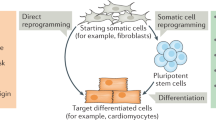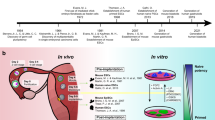Abstract
The increasing momentum of stem cell research continues, with the better characterization of induced pluripotent stem (iPS) cells, the conversion of differentiated cells into different cell types and the use of pluripotent stem cells to generate whole tissues, among other advances. Here, six experts in the field of stem cell research compare different stem cell models and highlight the importance of pursuing complementary experimental approaches for a better understanding of pluripotency and differentiation and an informed approach to medical applications.
This is a preview of subscription content, access via your institution
Access options
Subscribe to this journal
Receive 12 print issues and online access
$189.00 per year
only $15.75 per issue
Buy this article
- Purchase on Springer Link
- Instant access to full article PDF
Prices may be subject to local taxes which are calculated during checkout
Similar content being viewed by others
References
Takahashi, K. & Yamanaka, S. Induction of pluripotent stem cells from mouse embryonic and adult fibroblast cultures by defined factors. Cell 25, 663–676 (2006).
Kim, K. et al. Epigenetic memory in induced pluripotent stem cells. Nature 16, 285–290 (2010).
Kim, K. et al. Donor cell type can influence the epigenome and differentiation potential of human induced pluripotent stem cells. Nature Biotech. 29, 1117–1119 (2011).
Eiraku, M. et al. Self-organizing optic-cup morphogenesis in three-dimensional culture. Nature 472, 51–56 (2011).
Suga, H. et al. Self-formation of functional adenohypophysis in three-dimensional culture. Nature 480, 57–62 (2011).
Kobayashi, T. et al. Generation of rat pancreas in mouse by interspecific blastocyst injection of pluripotent stem cells. Cell 142, 787–799 (2010).
Acknowledgements
E.P. is a California Institute for Regenerative Medicine (CIRM, San Francisco, California, USA) New Faculty member and a scholar of the The American Society of Hematology (ASH).
Author information
Authors and Affiliations
Ethics declarations
Competing interests
Shinya Yamanaka is a member without a salary of the scientific advisory boards of iPierian, Inc., iPS Academia Japan and Megakaryon Corporation. George Q. Daley holds stock options at iPierian, Inc., and he receives consulting fees. Cédric Blanpain, Konrad Hochedlinger, Emmanuelle Passegué and Janet Rossant declare no competing financial interests.
Related links
Glossary
- Blastocysts
-
Structures that are formed during early embryogenesis in mammals. The fertilized embryo undergoes cleavage to produce blastomeres, which, after a fixed number of cell divisions, become compacted together. The outer cells form an epithelium (the trophoblast) that separates from the internal group of cells, which constitute the inner cell mass (ICM). The resulting structure comprising the trophoblast and the ICM is called the blastocyst.
- Epiblast
-
The inner layer of the developing embryo that originates from the inner cell mass (ICM) and gives rise to the fetus.
- Euchromatin
-
A form of chromatin that is lightly packed and often transcriptionally active during interphase.
- Heterochromatin
-
Highly compacted chromatin that is transcriptionally inactive. Includes structural regions of the chromosome that lack genes ('constitutive' heterochromatin, for example, centromeres) as well as genes that are silenced in a given cell type ('facultative' heterochromatin).
- Induced pluripotent stem cells
-
(iPS cells). Somatic cells that have been induced to become pluripotent through ectopic expression of four transcription factors — OCT4, SOX2, MYC and KLF4 (Krüppel-like factor 4).
- Naive state
-
A state of pluripotency in which cells are fully unrestricted and can give rise to all cell types of the embryo and later adult. This state is present only transiently during mammalian development, in the pre-implantation epiblast, and after culture of mouse embryonic stem cells in the presence of inhibitors of glycogen synthase kinase 3 (GSK3) and extracellular signal-regulated kinase (ERK).
- Niche
-
Specialized microenvironment in which stem cells reside. The nice produces signals that regulate stem cell identity and maintenance.
- Nuclear transfer
-
An experimental method to reprogram differentiated cells back to pluripotency. In this method, mammalian somatic cell nuclei are transplanted into a previously enucleated oocyte (unfertilized egg).
- Organotypic
-
A culture system in which the tissue, removed from an organ, continues to differentiate and develop as if it was in the original organ.
- Orthotopic
-
Transplantation of tissue or cells from a donor into its normal position in the body of the recipient.
- Reconstitution approaches
-
Differentiation of pluripotent stem cells into a tissue or an organ.
- Teratoma
-
An encapsulated, non-malignant tumour that comprises tissue or organ components resembling normal derivatives of all three germ layers.
- Transdifferentiation
-
The use of transcription factors (and, in some cases, chemical factors) to convert a differentiated cell type into another differentiated cell type, even between developmentally distant cells (belonging to different germ layers): for example, the conversion of fibroblasts to neurons.
Rights and permissions
About this article
Cite this article
Blanpain, C., Daley, G., Hochedlinger, K. et al. Stem cells assessed. Nat Rev Mol Cell Biol 13, 471–476 (2012). https://doi.org/10.1038/nrm3371
Published:
Issue Date:
DOI: https://doi.org/10.1038/nrm3371
This article is cited by
-
Efficient generation of functional neurons from mouse embryonic stem cells via neurogenin-2 expression
Nature Protocols (2023)
-
Roles and mechanisms of BAP1 deubiquitinase in tumor suppression
Cell Death & Differentiation (2021)
-
Genetically engineering self-organization of human pluripotent stem cells into a liver bud-like tissue using Gata6
Nature Communications (2016)
-
Drug Repositioning Approaches for the Discovery of New Therapeutics for Alzheimer's Disease
Neurotherapeutics (2015)



